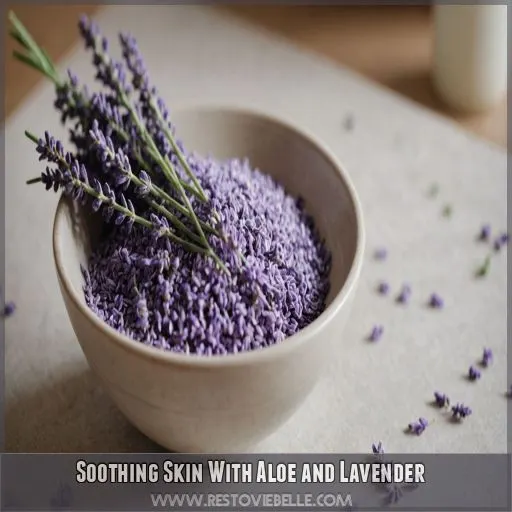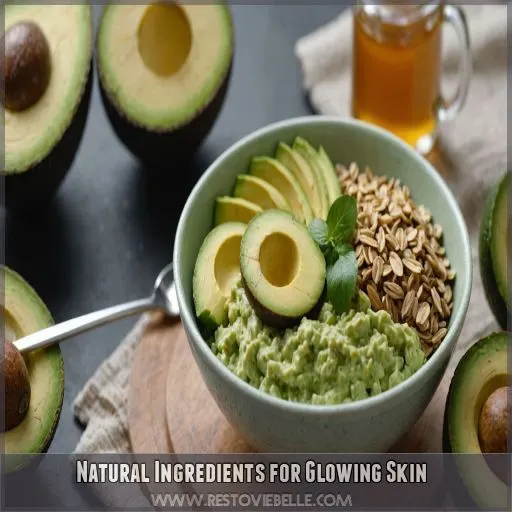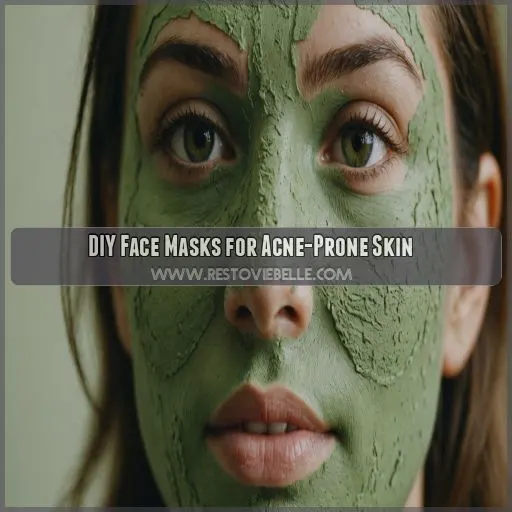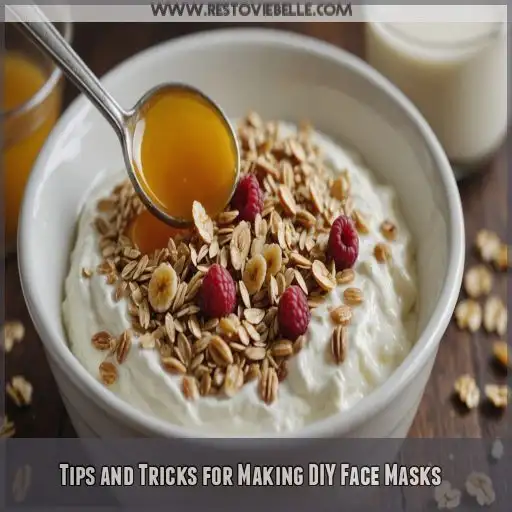This site is supported by our readers. We may earn a commission, at no cost to you, if you purchase through links.

A simple kitchen staple like baking soda gently buffs away dead skin cells, leaving your skin soft and radiant. Add honey for a hydrating, antibacterial boost.
For a deeper exfoliation, cinnamon and flax are acne-fighting powerhouses. Yogurt’s lactic acid and zinc also calm inflammation and promote glowing skin.
And if you’re craving some tropical vibes, pineapple and papaya are natural exfoliants that team up with brown sugar and honey for a sweet, enjoyable treat.
Intrigued? There’s more where that came from.
Table Of Contents
- Key Takeaways
- Glowing Skin Face Mask Essentials
- Crafting the Perfect Exfoliating Face Mask
- DIY Face Mask Recipes for Every Skin Concern
- Soothing Skin With Aloe and Lavender
- Brightening Skin With Blueberries and Oatmeal
- Natural Ingredients for Glowing Skin
- DIY Face Masks for Acne-Prone Skin
- DIY Face Masks for Dry Skin
- DIY Face Masks for Sensitive Skin
- Tips and Tricks for Making DIY Face Masks
- Frequently Asked Questions (FAQs)
- How do you make an exfoliating face mask at home?
- What is the best homemade facial exfoliator?
- What is the best homemade face mask?
- What is a good exfoliating face mask?
- How often should I use a face mask?
- How long should I leave the mask on for?
- Can I use fresh or frozen blueberries?
- How do I store my homemade masks?
- What ingredients should I avoid for sensitive skin?
- Conclusion
Key Takeaways
- There are a ton of kitchen staples that double as DIY face masks, like avocado, honey, and cinnamon. These natural ingredients can transform your skin, leaving it glowing and healthy.
- Turmeric, yogurt, and blueberries pack a punch when it comes to skincare. Turmeric soothes and reduces scars, yogurt exfoliates and brightens, and blueberries are packed with antioxidants for a youthful boost.
- Face masks aren’t just for pampering – they can be tailored to specific skin concerns. Whether you’re battling acne, dry skin, or redness, there’s a DIY mask recipe that’s your skin’s hero.
- Making your own face masks is a cost-effective way to treat your skin. With simple, organic ingredients, you can create effective, natural remedies and even make it a social occasion with DIY spa days.
Glowing Skin Face Mask Essentials
If you’re seeking a natural glow-up, DIY face masks are your new BFF. With the right ingredients, you can whip up a mask that’ll leave your skin beaming.
Benefits of DIY Face Masks
DIY face masks are a fun, cost-effective way to treat your skin. You can create natural, clean beauty treatments at home with simple, organic ingredients. The benefits include customisation to your skin type, and a regular, healthy skincare routine. You can even make it a social occasion and enjoy DIY spa days with friends.
Key Ingredients for Glowing Skin
Glowing skin, here we come!
Here are the key ingredients to include in your DIY face masks for that radiant, healthy glow:
- Turmeric: Known for its anti-inflammatory properties, turmeric helps soothe irritated skin and reduce acne scars.
- Yogurt or Buttermilk: These dairy products contain lactic acid, which exfoliates the skin and minimizes the appearance of pores.
- Raspberries or Blueberries: Packed with antioxidants, these berries help reduce scarring and soothe the skin.
- Coffee or Oatmeal: Natural exfoliants, they remove dead skin cells to reveal brighter, smoother skin.
Avocado Benefits for Skin
Avocados are a must-have for DIY face masks.
They’re rich in fatty acids, like a tall drink of water for your skin, plumping and moisturizing.
This super-fruit is also anti-aging, so it’ll help keep those wrinkles at bay.
Avocado oil is especially good for dry skin, and avocado masks can help with acne too.
Avocado face masks are a great, natural way to get that glow-up.
Turmeric Benefits for Skin
Turmeric is a powerful ingredient that can work wonders for your skin. Here are some of its key benefits:
- Anti-inflammatory properties: Turmeric helps to reduce skin inflammation, making it an excellent choice for acne-prone skin. Say goodbye to those pesky red bumps and hello to a calm, even complexion.
- Antioxidant boost: Packed with antioxidants, turmeric fights free radicals, protecting your skin from environmental damage and promoting a youthful glow. It’s like having a shield against the elements!
- Scar and hyperpigmentation reduction: The active compound in turmeric, curcumin, has been shown to reduce the appearance of scars and dark marks. This means that old acne scars or areas of hyperpigmentation can fade, leaving you with clear, radiant skin.
Yogurt or Buttermilk Benefits for Skin
Yogurt and buttermilk are like a tall glass of milk for your skin, but with extra benefits. They’re packed with lactic acid, a gentle exfoliator that sloughs off dead skin cells, revealing a brighter, more even complexion. Here’s a fun fact: lactic acid is also a natural skin brightener, so it helps fade dark spots and acne scars. It’s like a magic eraser for your skin!
| Ingredient | Skin Benefits | Sensitive Skin-Friendly |
|---|---|---|
| Yogurt | Exfoliation, Skin Brightening | Yes |
| Buttermilk | Exfoliation, Acne Treatment | Yes |
| Milk | Reduces Pore Size | Yes |
Yogurt and buttermilk are both excellent for exfoliating and brightening the skin, making them star ingredients in DIY face masks. They’re also gentle enough for sensitive skin, so everyone can enjoy their benefits without irritation.
Raspberries or Blueberries Benefits for Skin
Raspberries and blueberries are packed with antioxidants, making them a powerful addition to your skincare routine. These berries are like a super-food for your skin, reducing scarring and providing a soothing effect.
The natural fruit acids in raspberries and blueberries, such as citric and malic acid, gently exfoliate your skin, leaving it smooth and bright. Vitamin C and other antioxidants in these berries promote a radiant complexion, helping to fight the signs of aging and giving your skin a youthful boost.
Coffee or Oatmeal Benefits for Skin
Coffee or oatmeal—which will you choose for your next DIY face mask? Both ingredients offer exfoliating properties, leaving your skin feeling refreshed and looking brighter.
Here’s a breakdown of the benefits:
- Skin Brightening: Coffee acts as a natural exfoliant, sloughing off dead skin cells to reveal a brighter, more radiant complexion.
- Anti-Inflammatory Effects: Coffee’s anti-inflammatory properties can help soothe irritated skin and reduce acne scars.
- Gentle Exfoliation: Oatmeal provides a gentle, natural cleansing experience, making it ideal for sensitive skin.
Crafting the Perfect Exfoliating Face Mask
Want to make an exfoliating face mask that gets rid of dead skin and makes your face glow? You’re in the right place.
This section will talk about how to make the perfect exfoliating face mask.
We’ll cover everything from why certain ingredients are good for your skin to tips on how to apply it so your skin is smooth and radiant.
Blueberry Oatmeal Exfoliating Face Mask Recipe
Blueberries and oatmeal are a match made in skincare heaven. This dynamic duo delivers gentle exfoliation, vitamin C, and antioxidants for a radiant complexion. Here’s a simple recipe to craft your own herbal exfoliating face mask at home:
Ingredients:
- Mashed blueberries (fresh or frozen)
- Ground rolled oats
- Aloe vera gel
- Lavender hydrosol
Instructions:
- Combine the ingredients in a small bowl, adjusting the amounts to create a thick paste-like consistency.
- Apply the mask to damp skin after cleansing.
- Leave it on for 5-15 minutes, depending on your skin type.
- Rinse thoroughly with water, revealing smoother, brighter skin.
Application and Exfoliation Tips
When applying your blueberry oatmeal face mask, start with freshly cleansed skin. Use your fingers or a soft brush to gently smooth the mask onto your face, taking care around the delicate eye area.
For exfoliation, gently massage the mask into your skin in circular motions for a few seconds. Focus on areas that tend to get congested, like your T-zone or chin, but be mindful of your skin’s sensitivity. Adjust your touch or tools accordingly – your fingers, a soft washcloth, or a gentle brush can all work.
Benefits of Blueberries and Oatmeal for Skin
Blueberries are packed with natural fruit acids, gently exfoliating and brightening your complexion.
They’re also loaded with vitamin C and antioxidants, keeping your skin healthy and radiant.
Oatmeal steps in as a soothing, gentle exfoliator, removing dead skin cells to reveal smoother, brighter skin.
It also absorbs excess oil, leaving your skin feeling refreshed and clean.
DIY Face Mask Recipes for Every Skin Concern
Whether you’re dealing with tired under eyes, hyperpigmentation, or just want to give your skin a boost, there’s a DIY face mask recipe perfect for your needs. In this section, we’ll explore how to create your own face masks using natural ingredients to address a range of skin concerns, from exfoliation to hydration.
Exfoliating the Skin With Cinnamon and Nutmeg
Cinnamon and nutmeg are powerhouses for exfoliating and soothing your skin.
Cinnamon is a gentle exfoliator with anti-inflammatory benefits, helping to slough off dead skin cells and calm irritation.
Nutmeg works in a similar way, gently exfoliating while also reducing inflammation.
These spices are a great option for a DIY scrub, especially if you have sensitive skin.
They’re like a hug for your face, leaving it smooth and happy.
Minimizing Pores With Kaolin Clay
Kaolin clay is a superhero for minimizing pores and achieving that coveted smooth complexion.
Its superpower lies in its ability to absorb excess sebum, lift away dirt and debris, and calm redness, making it your go-to for clear and refined skin.
With a neutral pH, kaolin clay is especially kind to dry, sensitive, and acne-prone skin, so you can say goodbye to those pesky enlarged pores without irritating your delicate complexion.
Reducing Redness With Oatmeal
Say goodbye to redness and hello to calm, soothed skin! Oatmeal is a superstar ingredient for reducing redness and irritation. Here’s how to harness its powers:
- Use plain instant oatmeal: Opt for plain oatmeal without any added sugars or flavors.
- Application is key: Gently slather the oatmeal mixture onto your face and let it work its magic for 10-15 minutes. Then, rinse with cool water and follow up with your favorite serums and moisturizer.
- Oatmeal’s superpowers: Oatmeal contains antioxidants called avenanthramides, which help to calm and soothe irritated skin.
- Bonus tip: For extra relief, try adding a few drops of lavender essential oil to your oatmeal mixture. Lavender is known for its calming and anti-inflammatory properties, making it the perfect companion to oatmeal for reducing redness.
Tired Under Eyes With Coffee
We’ve all been there: dragging ourselves through the day with puffy eyes and dark circles. But fear not, coffee to the rescue! Caffeine constricts blood vessels, temporarily tightening and reducing the appearance of puffy under eyes. Here’s a DIY coffee face mask recipe to brighten up those tired peepers:
Coffee Eye Mask Recipe:
- Mix 1/2 tablespoon of coffee grounds with 1 teaspoon of raw honey until a thin paste forms.
- Smooth the mixture onto the under-eye area, extending up toward the brow bone.
- Leave the mask on for 10 minutes, then gently rinse with warm water, avoiding any tugging or rubbing.
Hyperpigmentation With Papaya and Turmeric
Papaya is a superhero for hyperpigmentation.
It’s packed with natural alpha hydroxy acids and a brightening enzyme called papain, which work together to fade dark spots and even out your skin tone.
Turmeric and lemon juice are a dynamic duo for lightening dark marks.
Honey adds thickness and has antimicrobial superpowers.
Apply this paste all over your face or use a cotton swab for specific areas.
Leave it on for 15-20 minutes, then rinse with warm water.
Soothing Skin With Aloe and Lavender
Want to give your skin some soothing TLC? Aloe vera and lavender are here to help. These two ingredients are like a spa day in a bottle, calming and hydrating your skin.
Benefits of Aloe Vera for Skin
Aloe vera is a superhero for skin issues, from rashes to acne. It’s nature’s soothing remedy, hydrating and calming irritated skin. Aloe gel or juice? Go for organic aloe gel for its purity. Calming and balancing, it’s perfect for sensitive skin.
Benefits of Lavender Hydrosol for Skin
- Gentle and Hydrating: Lavender hydrosol is like a spa in a bottle for your skin. Its calming properties make it ideal for soothing irritated skin and reducing acne breakouts.
- Acne Buster: Say goodbye to stubborn acne! Lavender hydrosol helps balance sebum production, so you can kiss oily skin and acne flare-ups goodbye.
- PH Rebalancing: It’s like a magic potion for your skin’s health, working to restore the natural pH balance and create a good environment for your complexion to thrive.
- Multi-Use: The versatility of lavender hydrosol is where it’s at! Use it directly in your face masks or get creative and make a lavender infusion.
- Shelf-Stable: No need to worry about it going bad. Store your lavender hydrosol in a cool, dark place, and it’ll keep its superpowers for ages.
How to Use Aloe and Lavender in Face Masks
So, you want to know how to use aloe and lavender in your face masks to soothe your skin? Well, here’s the lowdown.
- Direct Application: You can apply aloe vera gel or juice directly to your skin as a simple, natural remedy for irritation and acne.
- Mix with Other Ingredients: Combine aloe with lavender hydrosol and other natural ingredients like oatmeal and blueberries for a soothing mask.
- Lavender Infusion: Create a lavender infusion by mixing lavender hydrosol with other liquid ingredients like aloe vera juice or water. This adds a concentrated boost of lavender’s calming properties to your mask.
- Storage and Preservation: Store your homemade masks with lavender hydrosol in a cool, dark place to maintain their freshness and effectiveness.
Brightening Skin With Blueberries and Oatmeal
Brighten up dull skin and say hello to a radiant complexion with the power of blueberries and oatmeal. This dynamic duo works together to exfoliate and nourish your skin, revealing a brighter and smoother canvas.
Antioxidant Power of Blueberries
| Benefit | Description | Keyword |
|---|---|---|
| Antioxidants | Blueberries are rich in antioxidants, which help protect your skin from free radicals. | Free radical fighters |
| Vitamin C | This vitamin boosts collagen production, giving your skin a youthful appearance. | Collagen boost |
| Anti-aging | The antioxidants and vitamin C in blueberries work together to reduce the signs of aging. | Anti-aging benefits |
Blueberries are a great addition to your skincare routine, whether you’re whipping up a blueberry face mask or adding them to your diet for a healthy glow.
Exfoliating Properties of Oatmeal
Oatmeal is a superstar for exfoliating your skin. It’s like a gentle scrub, sloughing off dead skin cells and unclogging pores without the harshness of store-bought scrubs. The best part? It’s perfect for sensitive skin. No more redness and irritation. Just smooth, bright skin.
Say goodbye to dullness and hello to a radiant complexion with this natural wonder. It’s time to give your skin some love with oatmeal.
How to Make a Brightening Face Mask
Brighten your complexion with a blueberry and oatmeal face mask. Blueberries are packed with vitamin C and fruit acids like citric and malic acid, which gently exfoliate and promote a radiant complexion. Oatmeal calms irritated skin and acts as a natural cleanser and exfoliant, removing dead skin cells to reveal smoother, brighter skin.
Ingredients:
- 1/2 cup of yogurt
- A handful of mashed blueberries
- 1 teaspoon of ground rolled oats
- 1 teaspoon of honey (optional, for added hydration)
Instructions:
- Combine all ingredients in a small bowl.
- Apply the mask to damp, cleansed skin.
- Leave it on for 5-15 minutes, depending on your skin type.
- Rinse thoroughly with water.
- Follow up with your regular toner and moisturizer.
Natural Ingredients for Glowing Skin
Glowing skin is achievable with natural ingredients found in your kitchen. Learn about the benefits of avocado, turmeric, yogurt, berries, and more for a radiant, healthy complexion.
Honey Benefits for Skin
Honey is a superhero for your skin.
It’s packed with antibacterial properties that help fight acne and keep your complexion clear.
Honey is also a humectant, drawing moisture to your skin for a dewy, glowing look.
It’s a natural moisturizer, so it’s perfect for soothing dry or irritated skin.
Mountain Rose Herbs even offers a guide to creating your own herbal face mask with honey.
This natural ingredient is a must-have for any DIY skincare routine, and it’s suitable for all skin types.
You can also find honey in body butter and lip balm for an all-over hydrating experience.
Cinnamon Benefits for Skin
Cinnamon, a staple in your spice rack, is a surprise ingredient for glowing skin.
It’s a gentle exfoliator that buffs away dead skin cells, leaving your complexion smooth and radiant.
Cinnamon also has anti-inflammatory properties, calming irritated skin and reducing redness.
It’s like having your own personal spa treatment at home.
Just be cautious if you have sensitive skin – while cinnamon can be a great natural remedy, it’s potent, so always do a patch test first.
Kaolin Clay Benefits for Skin
Kaolin clay is a skincare superhero, especially if you’re dealing with oily or acne-prone skin.
Its superpower is absorbing excess sebum, which can clog pores and lead to breakouts.
It also gently lifts away dirt and impurities, leaving your skin feeling refreshed and clean.
Plus, its calming abilities can reduce redness, making it perfect for sensitive skin, too.
Kaolin clay has a neutral pH, so it won’t irritate your skin.
Papaya Benefits for Skin
Papaya is a tropical treat for your skin, packed with natural enzymes that work wonders as a gentle exfoliator.
Papain, a superstar enzyme in papaya, dissolves dead skin cells, revealing a brighter, smoother complexion.
Say goodbye to dullness and hello to a radiant glow.
Papaya’s also a natural source of alpha hydroxy acids, which help reduce the appearance of wrinkles and fine lines, giving you a youthful boost.
It’s like a tropical vacation for your skin!
DIY Face Masks for Acne-Prone Skin
Acne is a common skin concern.
You’re not alone if you’re dealing with it.
DIY face masks can be a great natural way to help manage breakouts.
This section explores DIY face mask recipes specifically designed for acne-prone skin.
You can learn how to create your own at-home treatments that may help improve your skin’s clarity and overall health.
Manuka Honey Face Mask Recipe
Looking for a natural way to tackle acne-prone skin? Try a DIY face mask with Manuka honey. Manuka honey is a powerhouse ingredient, known for its antibacterial and anti-inflammatory properties, making it an ideal base for a soothing and effective face mask. Here’s a simple recipe to get you started:
- 1 tablespoon Manuka honey
- 1 teaspoon lemon juice (freshly squeezed)
- 1/2 teaspoon cinnamon
- Mix all ingredients together in a small bowl.
- Apply a thin layer to your face, focusing on problem areas.
- Leave the mask on for 15-20 minutes.
- Rinse with lukewarm water and pat your skin dry.
This mask combines the benefits of Manuka honey with the brightening and exfoliating properties of lemon juice and cinnamon. Give it a go and see the power of natural ingredients at work!
Benefits of Manuka Honey for Acne
Manuka honey is a powerhouse ingredient for acne-prone skin, offering a range of benefits:
- Its natural antibacterial properties help fight acne-causing bacteria.
- Honey’s anti-inflammatory nature reduces redness and swelling associated with breakouts.
- The honey’s hydrating qualities promote skin healing and help prevent future acne scars.
- Manuka honey also gently exfoliates, removing dead skin cells and revealing a clearer complexion.
How to Use Manuka Honey in Face Masks
Now that you know the benefits of Manuka honey for acne-prone skin, let’s get into how to use it in your DIY face masks. Here’s a simple recipe to get you started:
Ingredients:
- 1 tablespoon Manuka honey
- 1 teaspoon lemon juice
- 1/2 teaspoon cinnamon
Instructions:
- Mix all ingredients together in a small bowl.
- Apply the mask to your face, avoiding the eye area.
- Leave it on for 15-20 minutes.
- Rinse with warm water and pat your skin dry.
Feel free to experiment with different ingredients and adjust the amounts to suit your skin’s needs. You can also add a teaspoon of yogurt or avocado for extra hydration.
DIY Face Masks for Dry Skin
Dry skin got you down? It’s time to quench that parched complexion with some DIY face masks designed specifically for dry skin. Get ready to transform your skin from Sahara-esque to dewy and glowing with these easy-to-make, natural remedies.
Cocoa Powder Face Mask Recipe
Here’s a simple cocoa powder face mask recipe for all you chocolate lovers out there! This DIY face mask is perfect for those with dry skin, leaving your complexion glowing and nourished.
- 1 tablespoon of cocoa powder
- 1 teaspoon of honey
- A splash of milk (or water)
- Mix the ingredients together to form a smooth paste.
- Gently apply the mask to your face, avoiding the eye area.
- Leave it on for 10-15 minutes.
- Rinse with warm water, revealing soft and glowing skin.
There you have it! A delicious-sounding and effective DIY face mask using cocoa powder.
Benefits of Cocoa Powder for Skin
Cocoa powder is a skin-rejuvenating superhero, packed with antioxidants to fight off those pesky free radicals that cause wrinkles and fine lines.
It’s like having your own personal superhero fighting off the signs of aging.
Cocoa powder is also a friend to acne-prone skin, helping to keep those breakouts at bay.
And for those dry skin days, it’s a natural moisturizer, leaving your skin feeling soft and supple.
How to Use Cocoa Powder in Face Masks
Now that you know the benefits of cocoa powder, here’s how to incorporate it into your DIY face masks for dry skin:
- Simple Cocoa Powder Mask: Mix 1 tablespoon of cocoa powder with enough water to form a paste. Apply to your face and leave on for 10 minutes. Rinse with warm water.
- Cocoa Honey Mask: Combine 1 tablespoon of cocoa powder, 1 teaspoon of honey, and a few drops of milk. Mix until you have a smooth paste. Gently massage the mask into your skin and leave it on for 15 minutes. Rinse with lukewarm water.
- Cocoa Avocado Mask: Mash half a ripe avocado and mix it with 1 tablespoon of cocoa powder. Apply the mask to your face and relax for 20 minutes. Rinse with warm water and pat your skin dry.
- Cocoa Yogurt Mask: Mix 1 tablespoon of cocoa powder with 2 tablespoons of plain yogurt. Apply the mask to your face and neck, and leave it on for 15 minutes. Rinse with cool water, and your skin will feel soft and supple.
DIY Face Masks for Sensitive Skin
If you’ve got sensitive skin, you know the struggle of finding products that won’t irritate your complexion. Luckily, DIY face masks offer a gentle, natural solution.
Oatmeal is a key ingredient for soothing sensitive skin, offering gentle exfoliation and relief from redness and irritation.
Oatmeal Face Mask Recipe
Here’s a simple oatmeal face mask recipe, perfect for sensitive skin:
Ingredients:
- Plain instant oatmeal (unsweetened and unflavored)
- Water or milk (optional)
Instructions:
- Prepare the oatmeal according to the package instructions. For sensitive skin, it’s best to use water or a gentle milk.
- Let the oatmeal cool down to a comfortable temperature.
- Gently apply the oatmeal to your face, avoiding the eye area.
- Relax and leave the mask on for 10-15 minutes.
- Rinse with cool water and pat your skin dry.
This oatmeal mask is a gentle and natural way to soothe and exfoliate sensitive skin.
Benefits of Oatmeal for Sensitive Skin
Oatmeal is a superhero for sensitive skin. It’s like a soothing hug for your face, calming irritation and redness. Oatmeal’s anti-inflammatory powers make it a go-to for eczema warriors, and its gentle exfoliation sweeps away dead skin cells, revealing a brighter, smoother complexion. It’s like a spa day and a skin savior rolled into one.
How to Use Oatmeal in Face Masks
Oatmeal is a gentle, natural exfoliant that’s perfect for sensitive skin. Here’s how to use it in a face mask:
- Ingredients: All you need is plain instant oatmeal (make sure it’s free from added sugars or flavors) and water. You can also add a few drops of lavender hydrosol for extra soothing benefits.
- Preparation: Mix the oatmeal with enough water to form a thick paste. If using lavender hydrosol, add a few drops and stir.
- Application: Gently slather the oatmeal paste onto your face, avoiding the delicate eye area. Let it sit for 10-15 minutes.
- Rinsing: Rinse the mask with cool water, patting your skin dry with a soft towel.
- Frequency: You can use this oatmeal mask 1-2 times a week for a soothing, exfoliating treatment.
Tips and Tricks for Making DIY Face Masks
Now that you’ve got the basics down, it’s time to level up your DIY face mask game. We’ll be diving into tips and tricks to enhance your homemade mask experience, from storage solutions to customization ideas.
Get ready to glow up with pro tips that’ll take your DIY face masks from good to glowing great.
How to Store Homemade Face Masks
Now that you’ve crafted your DIY face masks, it’s important to know how to store them properly so they stay fresh and effective. Here are some tips:
- Refrigerator Storage: Store your homemade masks in airtight containers in the refrigerator. This helps keep them good for longer and keeps the ingredients fresh. Aim for no more than 3 days in the fridge.
- Freezing Masks: If you’ve made a large batch, consider freezing your masks in ice cube trays. That way, you can pop out a single serving when needed.
- Mask Preservation: To make your masks last longer, always use clean utensils and containers. Avoid introducing bacteria by not dipping your fingers into the mask.
How to Customize Face Masks for Skin Type
Customizing face masks for your skin type is a fun part of the DIY process. You can tweak the ingredients to align with your unique skin goals. Here are some tips:
- Skin type: If you have oily skin, you might want to use ingredients that absorb excess oil, like oatmeal or kaolin clay. For dry skin, focus on hydrating ingredients like avocado or honey.
- Mask goals: Are you looking to exfoliate, minimize pores, or reduce redness? Choose ingredients that align with your specific goals. For example, cinnamon and nutmeg gently exfoliate, while kaolin clay minimizes pores.
- Ingredient swaps: You can swap out ingredients based on your preferences or what’s available in your kitchen. For instance, if a recipe calls for raspberries, you can use blueberries instead, as they offer similar benefits.
Precautions and Safety Tips for DIY Face Masks
There are a few things to keep in mind to make sure your DIY face mask experience is safe and effective:
- Patch testing: Always do a patch test on a small area of skin first to avoid any nasty reactions.
- Ingredient allergies: Know your allergies and avoid ingredients that might trigger them.
- Skin sensitivity: If you’ve got sensitive skin, steer clear of harsh ingredients and strong exfoliants.
- Storage: Keep your homemade masks in the fridge and use ’em within a few days to keep things fresh.
- Usage frequency: Don’t overdo it. Space out your treatments to avoid irritating your skin.
Frequently Asked Questions (FAQs)
How do you make an exfoliating face mask at home?
Mix yogurt, berries, coffee, and turmeric. Apply and gently massage for 20 seconds. Leave on for 20–30 minutes, then rinse.
What is the best homemade facial exfoliator?
The best homemade facial exfoliators are made from natural ingredients like brown sugar, oats, avocado oil, and essential oils. These exfoliators can help remove dead skin cells, leaving your skin feeling refreshed and smooth.
What is the best homemade face mask?
A good face mask is a real game-changer. For a glow-up, try a DIY face mask with yogurt, berries, coffee, and turmeric. It’s a winning combo for bright, happy skin.
What is a good exfoliating face mask?
Want an exfoliating face mask that’s gentle on your skin? Try Coming Up Roses by The Organic Skin Co. It’s pH-balanced, packed with vitamins and antioxidants, and made with bamboo stem particles for gentle, tear-free exfoliation.
How often should I use a face mask?
It depends on your skin type, skin needs, and the type of mask. Hydrating masks can be used daily, while charcoal and exfoliating masks are best used once or twice a week.
How long should I leave the mask on for?
That depends on the mask. Some masks, like the blueberry oatmeal one, suggest 5 minutes for sensitive skin and 10–15 minutes for other skin types. For the coffee and honey eye mask, 10 minutes is enough.
Can I use fresh or frozen blueberries?
You can use either fresh or frozen blueberries for your face mask. Fresh blueberries are packed with vitamin C and antioxidants for a radiant complexion.
How do I store my homemade masks?
Store your homemade masks in the refrigerator to keep them fresh. They’ll last up to three days, so you can enjoy multiple spa days without wasting ingredients.
What ingredients should I avoid for sensitive skin?
For sensitive skin, avoid harsh exfoliants like sugar scrubs. Steer clear of direct applications of lemon and apple cider vinegar, which can cause light sensitivity and skin bleaching. Glycolic acid is another no-go for sensitive skin.
Conclusion
There you have it—a DIY skincare toolkit to whip up homemade exfoliating face masks for every skin type and concern.
From acne-prone to dry and sensitive skin, you’re now equipped with a range of natural ingredients and recipes to achieve that coveted glow.
So, roll up those sleeves, grab your mixing bowls, and get ready to pamper your skin with some exfoliating, hydrating, and skin-soothing magic.
Happy masking!
















